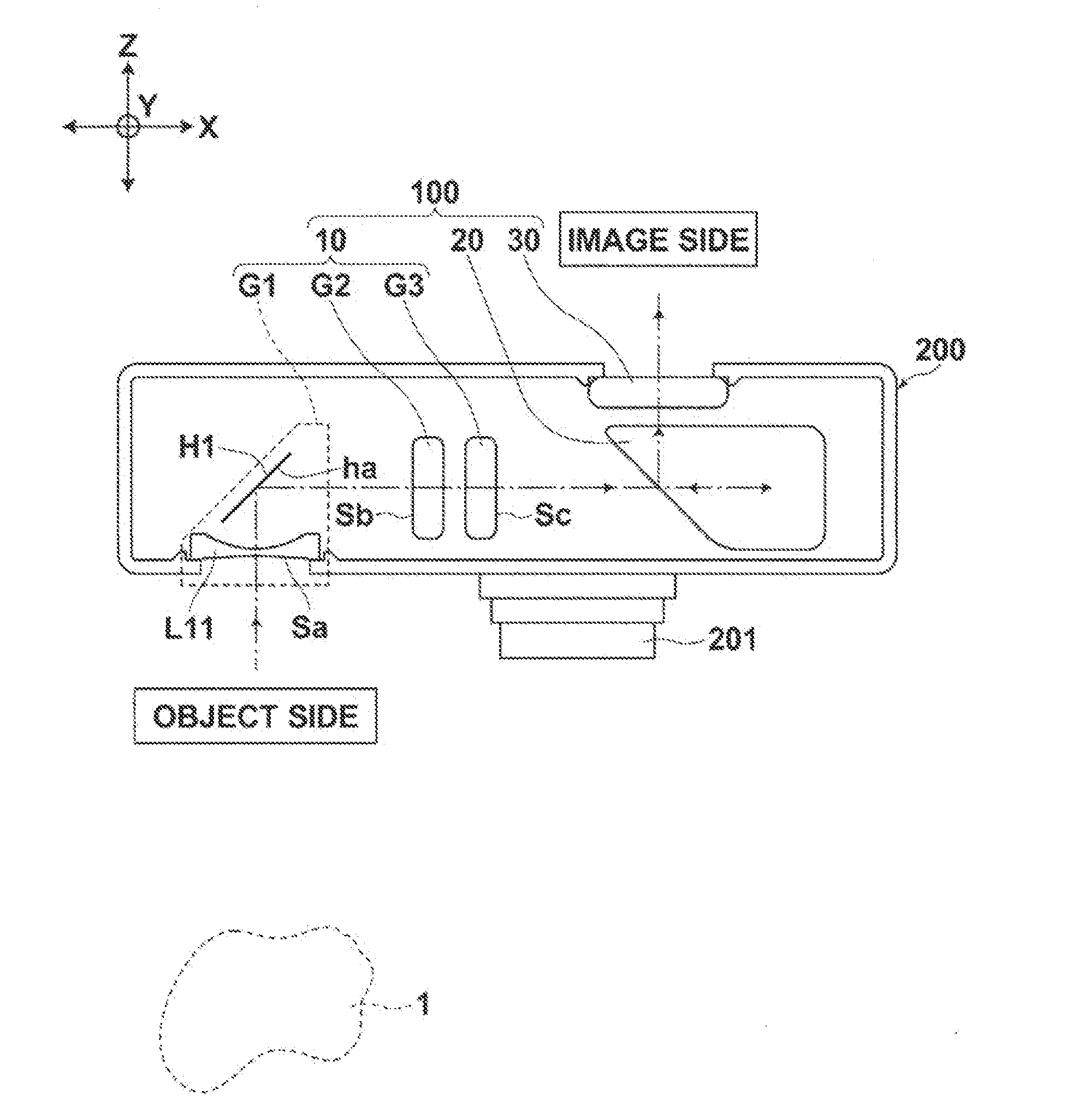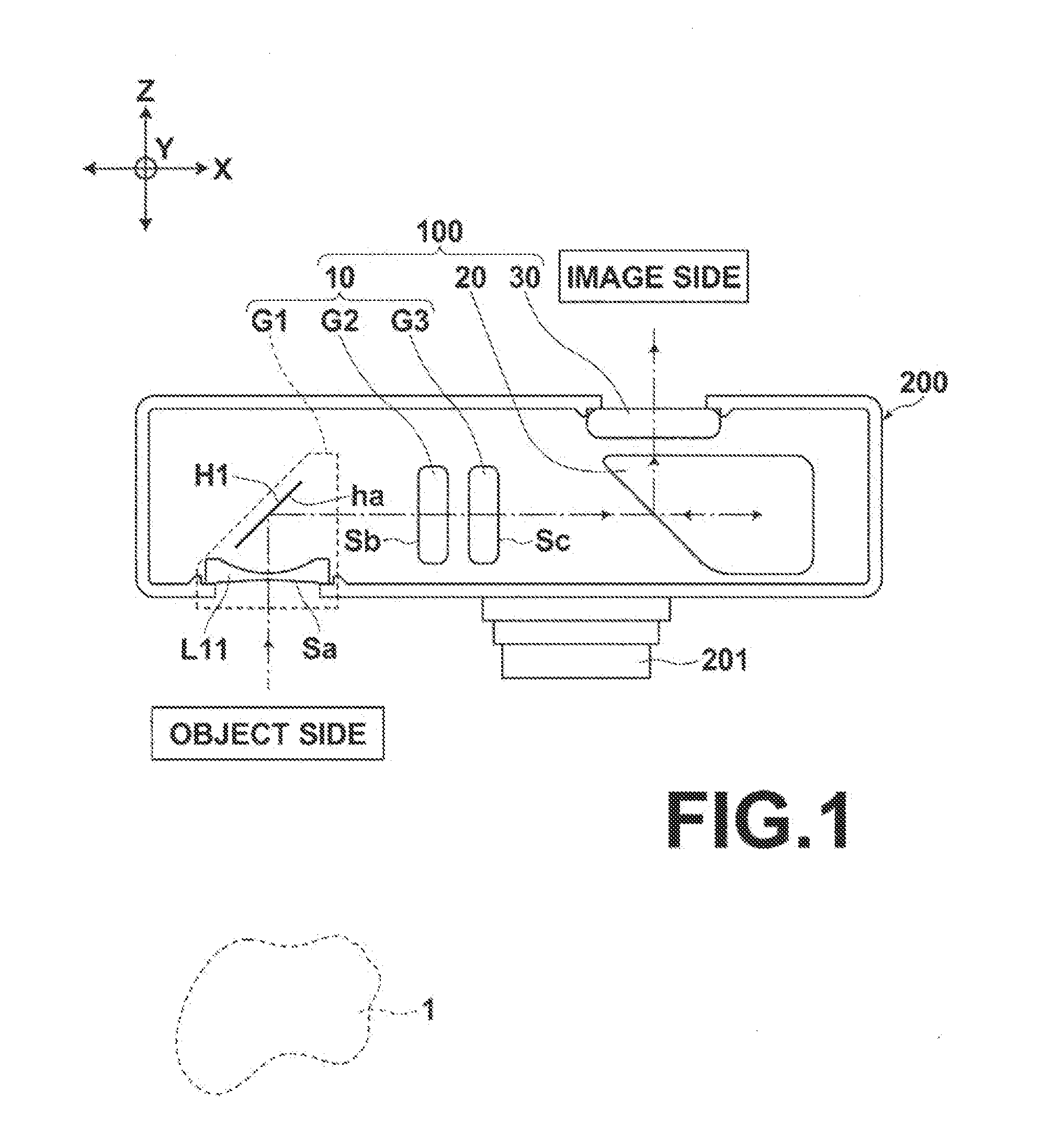Real-image zoom viewfinder and imaging apparatus
a technology of which is applied in the field of real-image zoom viewfinder and imaging apparatus, can solve the problems of difficult to achieve sufficient thickness reduction, difficult to achieve the reduction of thickness while ensuring a zoom ratio of around 4:1, etc., and achieves the reduction of optical path length, shorter optical path length, and longer optical path length
- Summary
- Abstract
- Description
- Claims
- Application Information
AI Technical Summary
Benefits of technology
Problems solved by technology
Method used
Image
Examples
example 1
[0081]FIG. 6 is a diagram illustrating a developed view of the configuration and the optical path of the real-image zoom viewfinder of Example 1.
[0082]Table 1A, which will be described later, shows data about the real-image zoom viewfinder of Example 1. Lens data is shown in the upper table of Table 1A, and data relating to zoom of the real-image zoom viewfinder is shown in the lower table of Table 1A.
[0083]In the lens data shown in the upper table of Table 1A, each value in the column of “Surface number Si” represents the surface number of the i-th (i=1, 2, 3, . . . ) lens surface, or the like, where the number is sequentially increased from the most object-side surface toward the image side.
[0084]Each value in the column of “Radius of curvature Ri” represents the radius of curvature of the i-th (i=1, 2, 3, . . . ) surface. Each value in the column of “Surface interval Di” (i=1, 2, 3, . . . ) represents the surface interval between the i-th surface and the i+1-th surface along the ...
example 2
[0100]FIG. 7 is a diagram illustrating a developed view of the configuration and the optical path of the real-image zoom viewfinder of Example 2.
[0101]Table 2A shows data about the real-image zoom viewfinder of Example 2. Lens data is shown in the upper table of Table 2A, and data relating to zoom of the real-image zoom viewfinder is shown in the lower table of Table 2A.
TABLE 2AExample 2SurfaceRadiusSurfaceAbbenumber Siof curvature Riinterval DiRefractive index Njnumber νj*118.74221.8001.58364130.27*25.29651.4003∞7.6281.84666023.784∞D4532.1362.5001.49023357.45*6−13.8448D6721.34761.7501.48749070.23865.0217D89∞9.0001.49023357.4510∞0.50011∞19.125 1.49023357.4512∞3.3791345.6734.5001.49023357.45*14−10.3661Data relating to zoomSpecificationsWide-angle endTelephoto endFinder magnification: m0.431.72Angle of field: 2ω58.313.3Interval: D425.6482.458Interval: D611.0522.140Interval: D89.95442.056*aspherical surface
[0102]Table 2B shows aspherical coefficients representing the shape of each asph...
example 3
[0106]FIG. 8 is a diagram illustrating a developed view of the configuration and the optical path of the real-image zoom viewfinder of Example 3.
[0107]Table 3A shows data about the real-image zoom viewfinder of Example 3. Lens data is shown in the upper table of Table 3A, and data relating to zoom of the real-image zoom viewfinder is shown in the lower table of Table 3A.
TABLE 3AExample 3SurfaceRadiusSurfaceAbbenumber Siof curvature Riinterval DiRefractive index Njnumber νj*114.7921.8001.58364130.27*24.15671.4003∞7.6281.84666023.784∞D4519.43742.5001.49023357.45*6−12.4582D6714.27341.7501.48749070.23833.1381D89∞9.0001.49023357.4510∞0.50011∞19.125 1.49023357.4512∞2.0001323.00913.0001.49023357.45*14−12.9246Data relating to zoomSpecificationsWide-angle endTelephoto endFinder magnification: m0.301.21Angle of field: 2ω69.617.2Interval: D419.6871.454Interval: D60.5000.667Interval: D89.72027.786*aspherical surface
[0108]Table 3B shows aspherical coefficients representing the shape of each asph...
PUM
 Login to View More
Login to View More Abstract
Description
Claims
Application Information
 Login to View More
Login to View More - R&D
- Intellectual Property
- Life Sciences
- Materials
- Tech Scout
- Unparalleled Data Quality
- Higher Quality Content
- 60% Fewer Hallucinations
Browse by: Latest US Patents, China's latest patents, Technical Efficacy Thesaurus, Application Domain, Technology Topic, Popular Technical Reports.
© 2025 PatSnap. All rights reserved.Legal|Privacy policy|Modern Slavery Act Transparency Statement|Sitemap|About US| Contact US: help@patsnap.com



